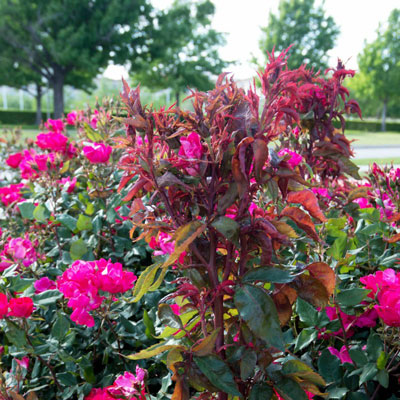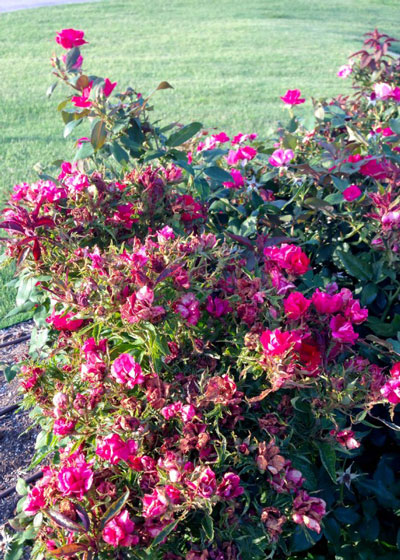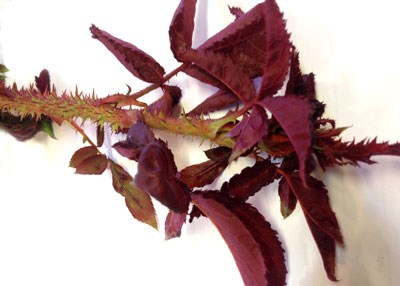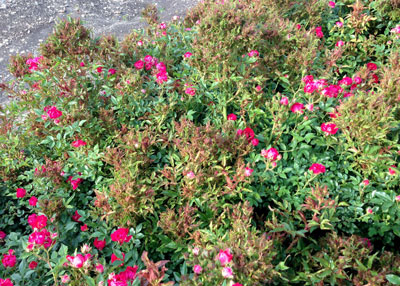Rose Rosette Conference

Photo: Strong “bull canes” are first symptom that something is horribly amiss.
Rose rosette virus is awful. When it hits a plant in your garden, it probably has already spread through the neighborhood. If not, it soon will. The saddest part of it all is that there is no prevention, nor is there a cure.
If you want to learn about RRV from Texas’ best experts, attend this event:
Rose Rosette Symposium
Saturday, November 12, 8:30 – 12:30
Chambersville Tree Farms
7032 County Road 971
Celina TX 75009
972-837-4223
The Program:
• Maddi Shires, PhD Student in Plant Pathology and Microbiology at TAMU
Introduction to Rose Rosette Disease
• Dr. Greg Church, Collin County Extension Horticulturist
RRV Epidemic in Collin County
• Dr. James Amrine, Professor Emeritus, Entomology, West Virginia University
Important Points in Spread of RRV in Roses
• Dr. Mark Windham, Professor in Ornamental Pathology, UTIA
Management Strategies for RRV: Proactive vs. Reactive
• Dr. David Byrne, Professor and Basye Endowed Chair in Rose Genetics, TAMU
Challenges of Breeding RRV-Resistant Roses
Dr. Kevin Ong, Director of Texas Plant Disease Diagnostic Lab at TAMU
Finding RRV-Tolerant/Resistant Roses…How can YOU help?
There is no charge for the meeting. No prior registration is required. Mark your calendar!

Photo: This bed of Knockout roses is infested with rose rosette virus.
Facts of Rose Rosette Virus
Let’s give you some of the basics so you can see if your plants are already involved. Sadly, most roses in the Metroplex area are.
Symptoms:
• Extremely strong “bull canes” emerging from the crowns of the plants. The canes are much larger than the normal canes. They have red pigmentation, and they will be exceedingly thorny – perhaps 10 times the number of thorns on the other canes on the plants.

Photo: Thick, red and extremely thorny cane is sure proof of rose rosette virus infection.
• Flowers fail to open properly. Eventually bud production is greatly reduced and the plants quit blooming almost entirely.
• Plants weaken by autumn and especially during the second year of infection.

Photo: By end of first season of RRV infection, plants will show significant weakening and very poor production of buds.
Thousands of Metroplex rose growers have had to remove their entire plantings due to the fatal rose rosette virus. They’re afraid to plant replacement roses.
How it is spread:
• Most rose rosette is spread by a microscopic, wind-blown mite. We have no chemical control for the mite, and you probably won’t be aware that they’re even in your neighborhood until your plants are completely infected.
• Rose rosette virus can also be spread from plant to plant and on pruning tools that have not been disinfected with rubbing alcohol between cuts.
What to do if you find RRV:
• Remove all affected plants immediately. Dig the plants with roots intact. Place them in black plastic trash bags. Tie the bags shut and send them off to the landfill.
• DO NOT ATTEMPT TO PRUNE THE PLANTS to remove the diseased portions. Once any part of a plant has RRV, the entire plant is involved.
• DO NOT FALL FOR QUACK HOME REMEDIES. I’m not even going to mention them by name, because research has shown them to be completely ineffective.
• COMMERCIAL LANDSCAPES are often the source of neighborhood contamination. Crews are sent in without training, told to prune and “clean up the rose beds” to even up the erratic growth. Infected plants are left to pollute, often for years.
Note: I am commonly asked to suggest plants that could take the roses’ places and give generally the same looks. Unfortunately, that’s really not possible. Only roses look like roses. Tall annual color and evergreen shrubs that have some manner of annual bloom are your best candidates. Let your local nurseryman work with you on ideas.
